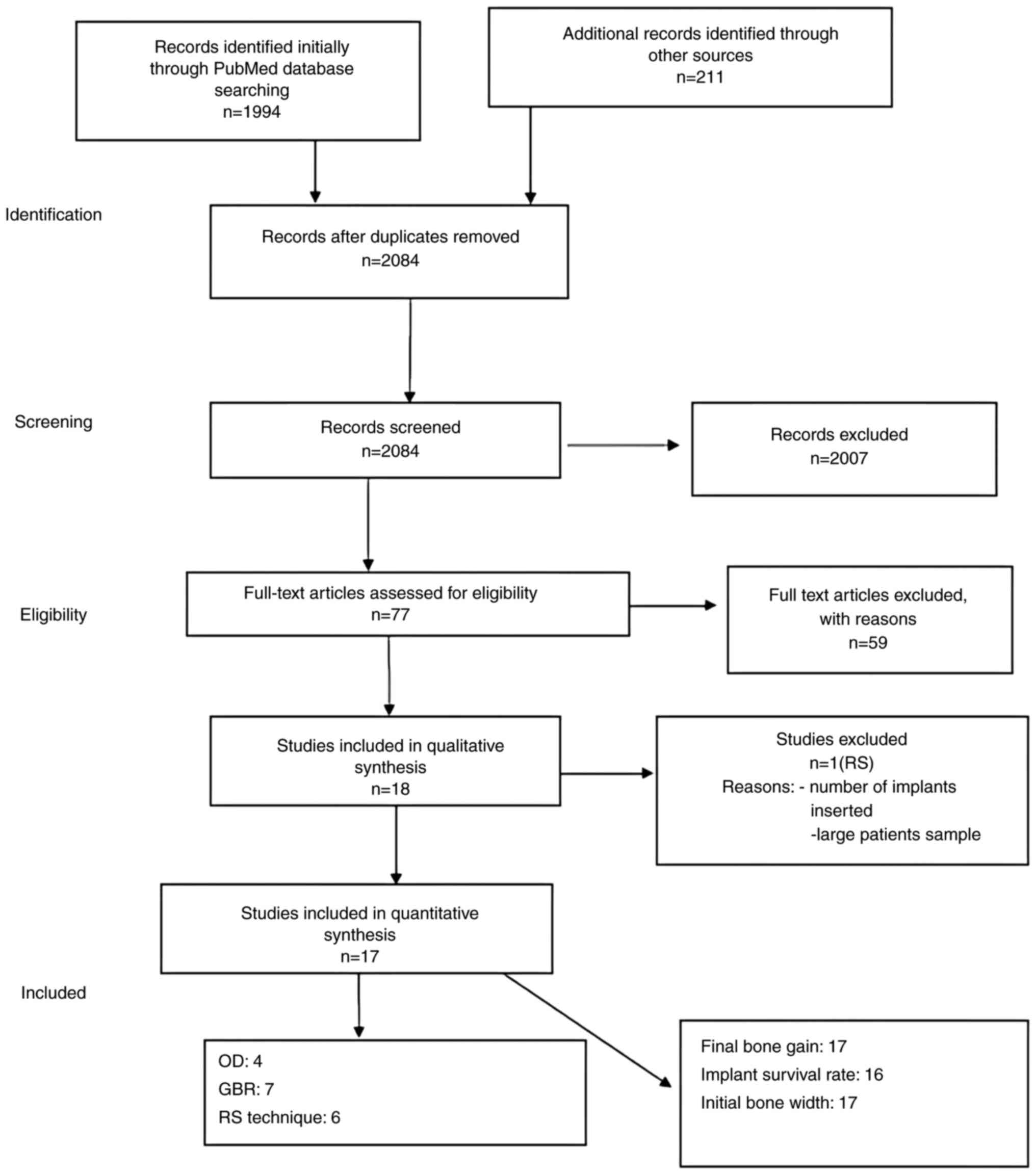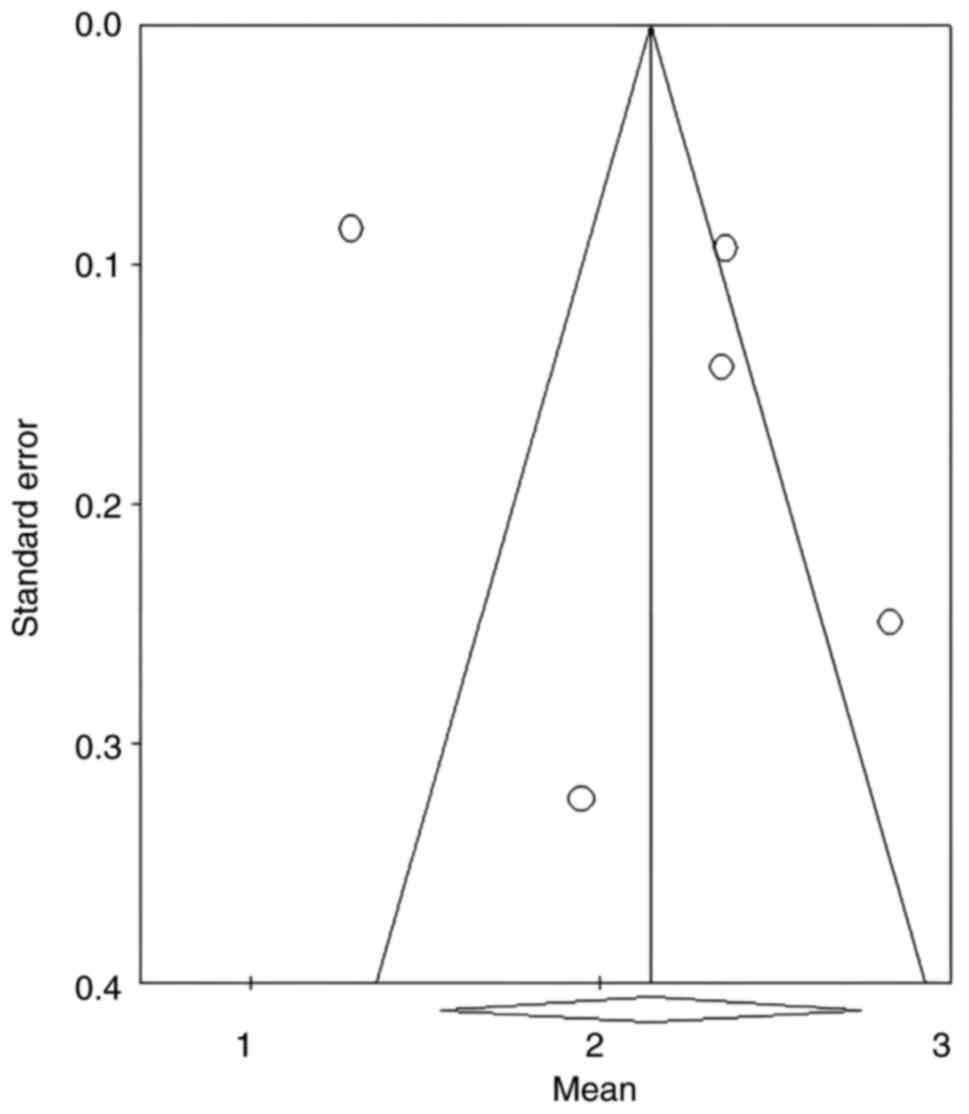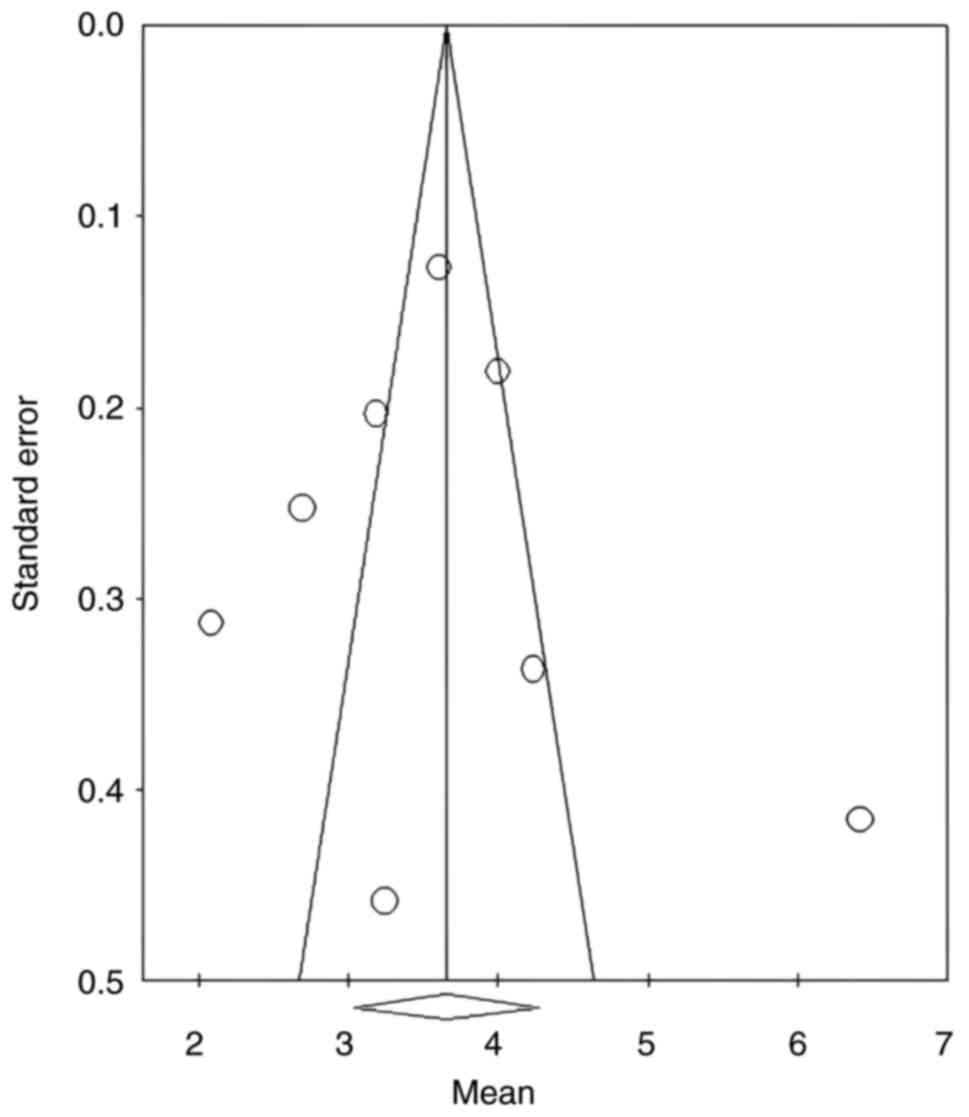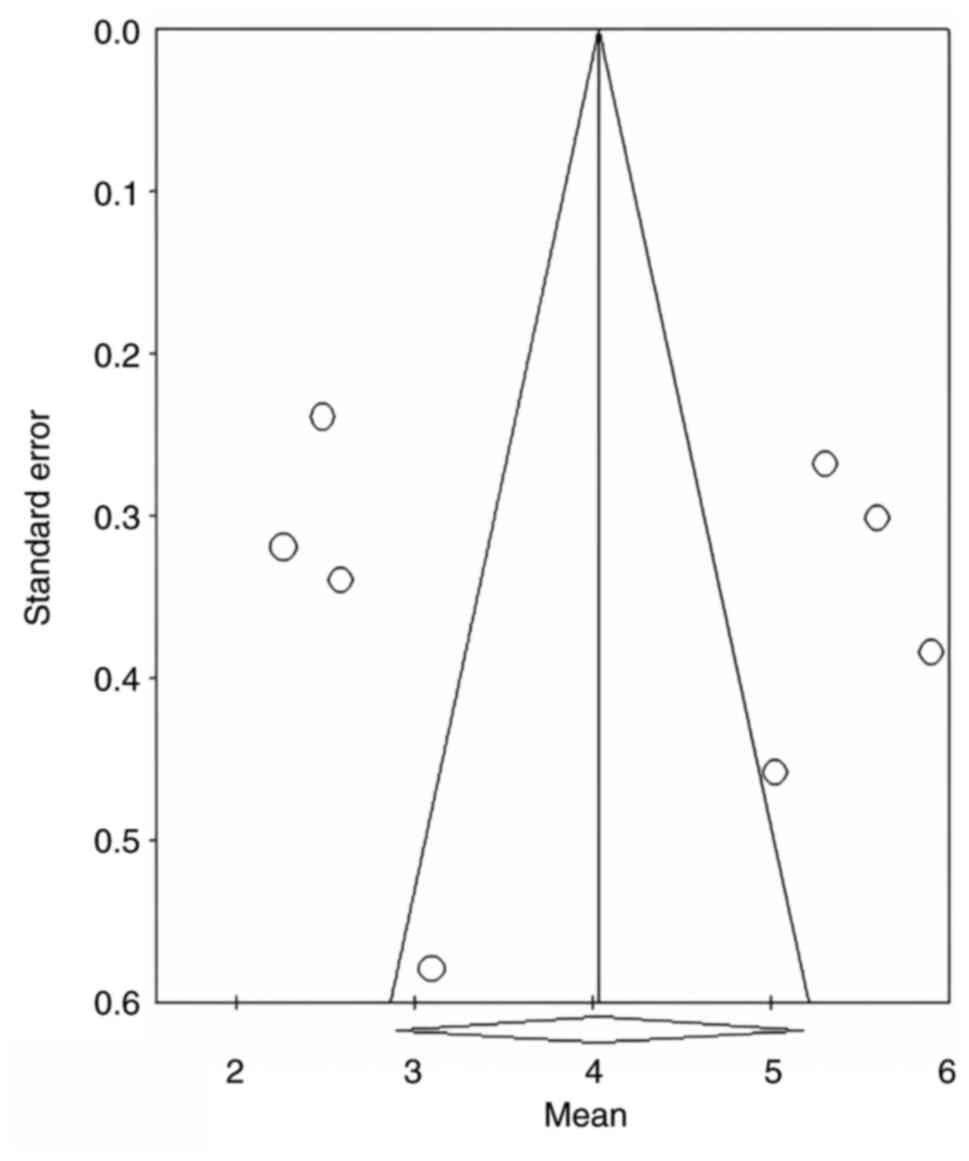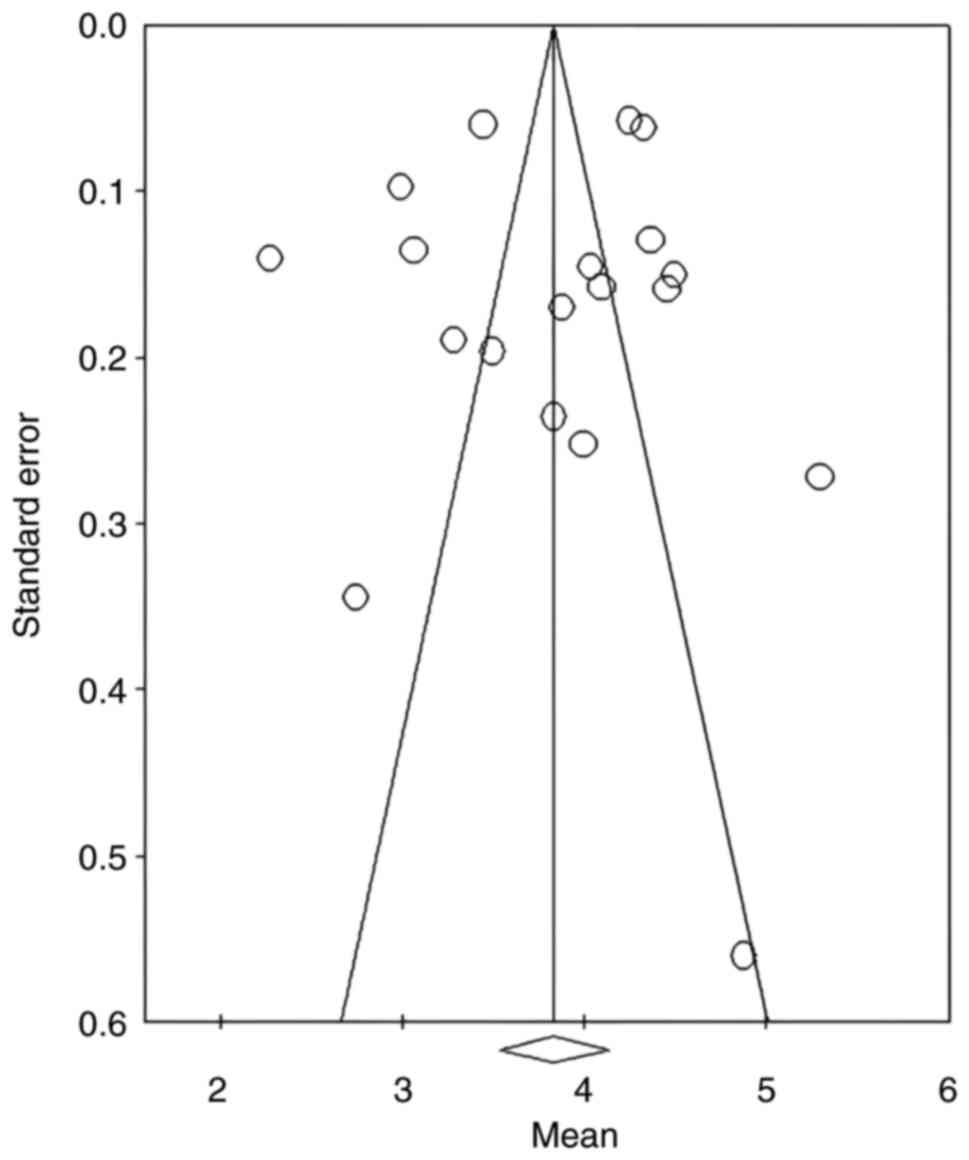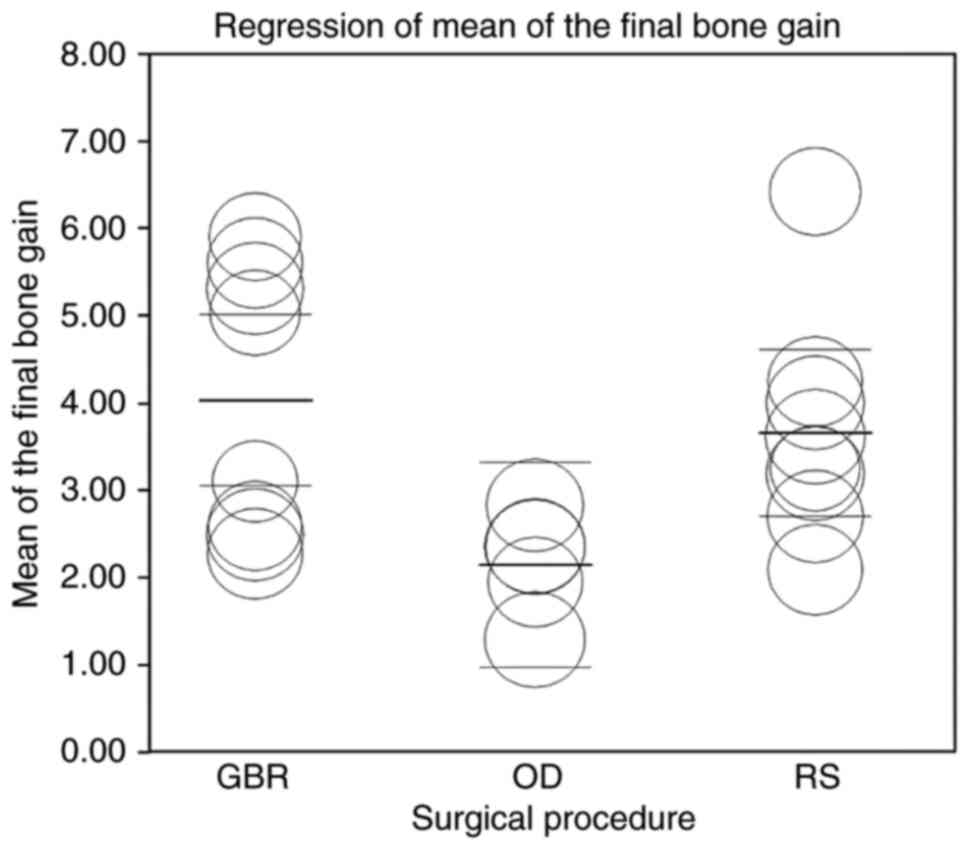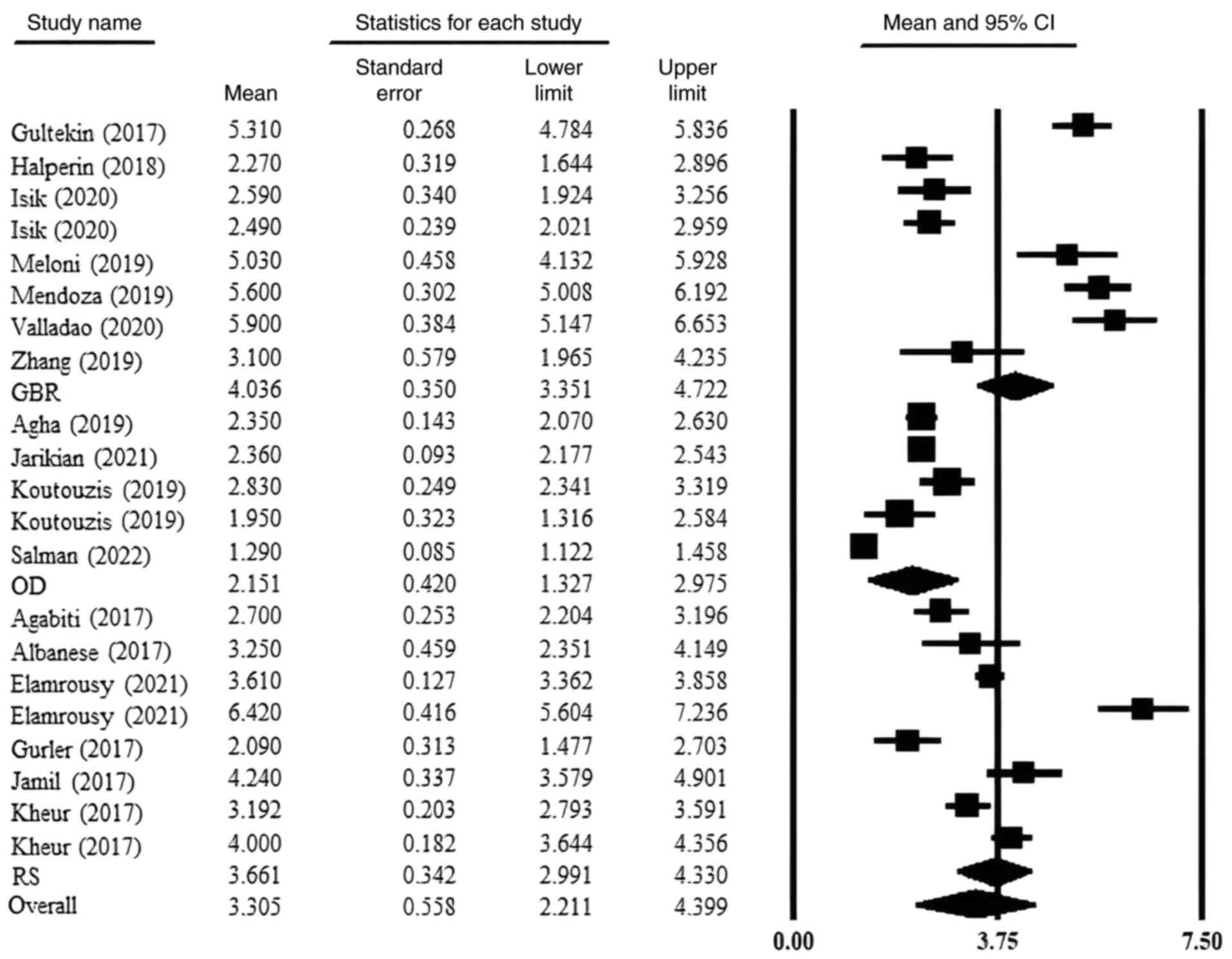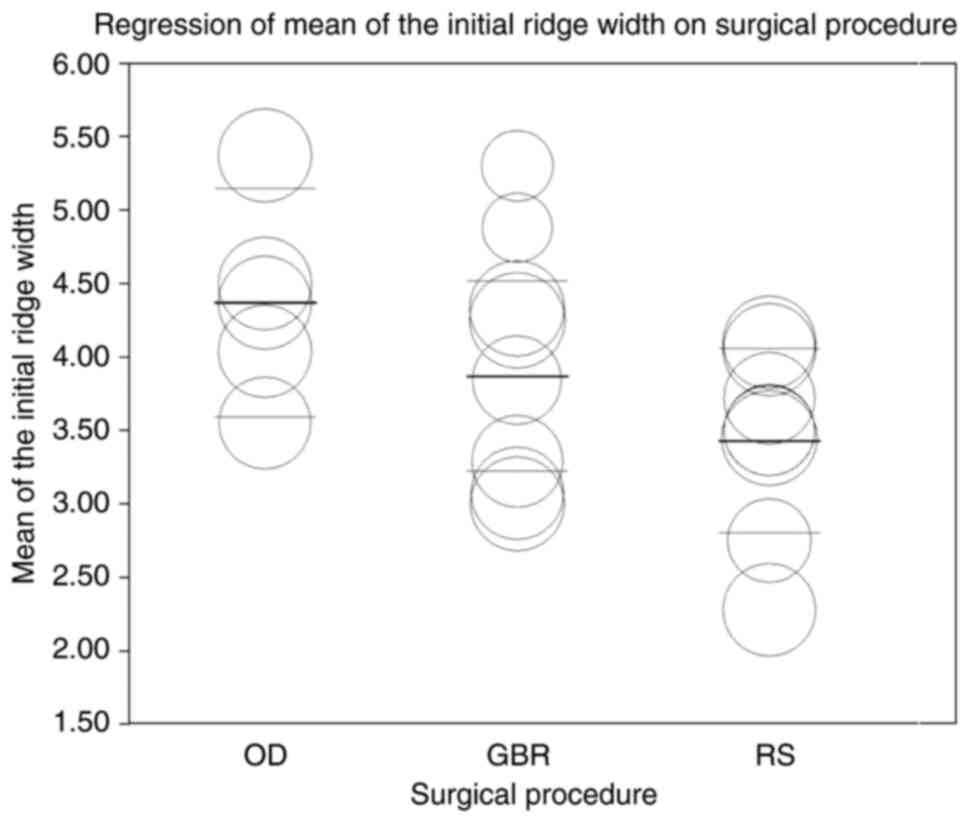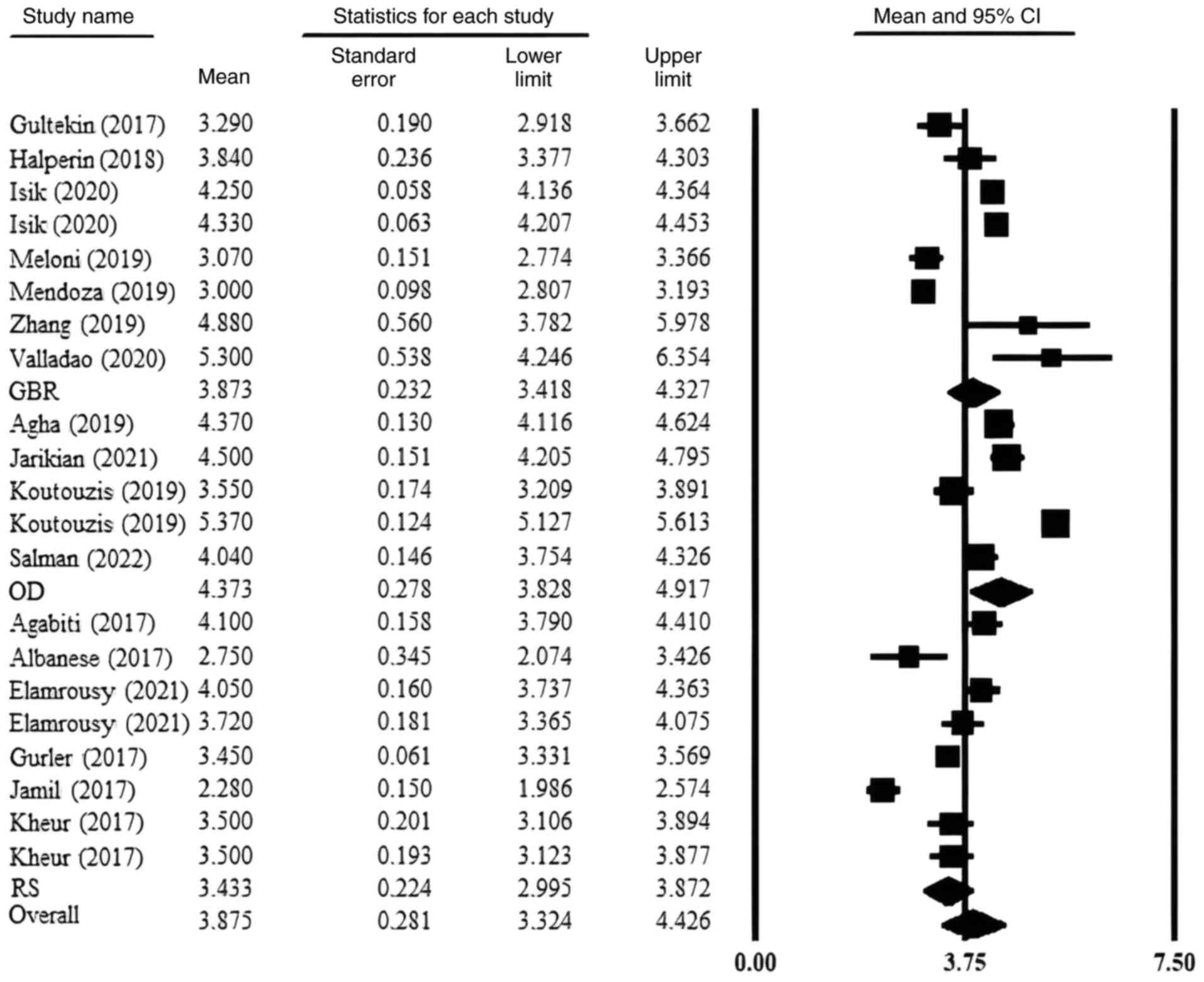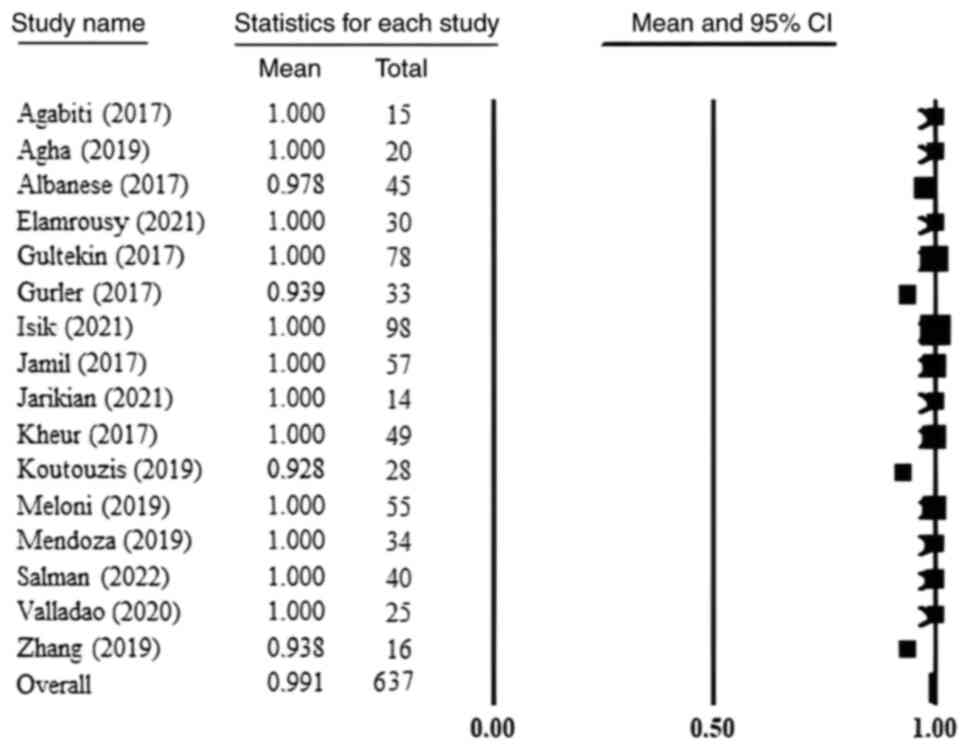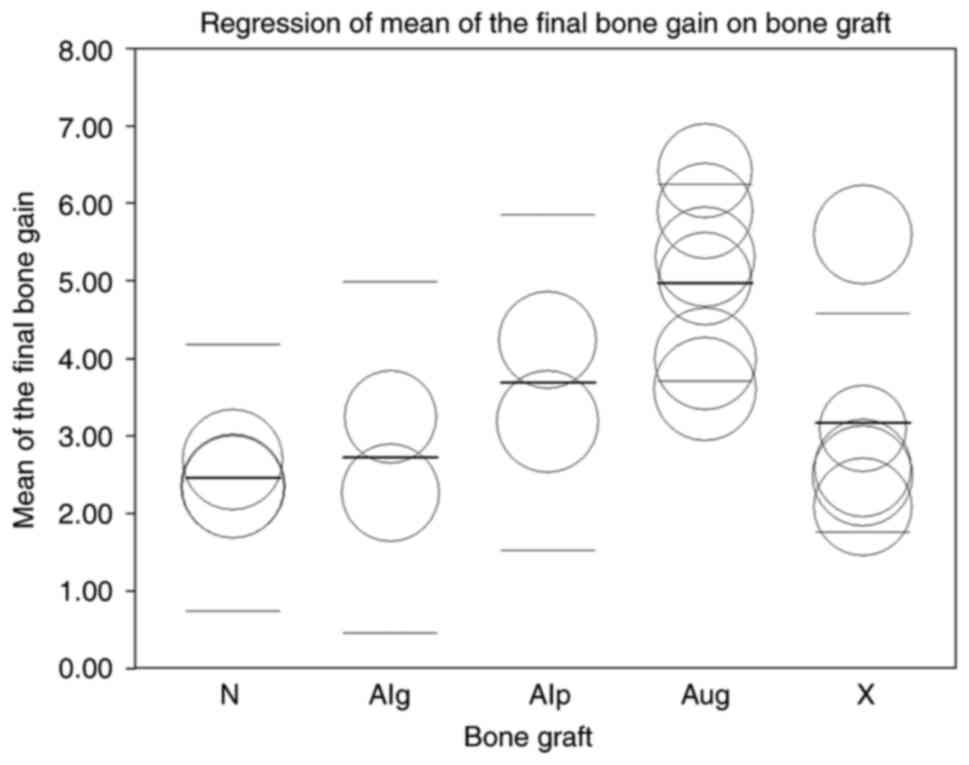Horizontal ridge augmentation through ridge expansion via osseodensification, guided bone regeneration and ridge‑split: Systematic review and meta‑analysis of clinical trials
- Authors:
- Published online on: July 31, 2024 https://doi.org/10.3892/br.2024.1827
- Article Number: 139
-
Copyright: © Vorovenci et al. This is an open access article distributed under the terms of Creative Commons Attribution License.
Abstract
Introduction
Bone augmentation has taken different forms over time, depending partly on the experience of the surgeon but also on the available bone of the patient. Following tooth extraction, bone resorption from the jawbone occurs within 12 months (1,2). Most of this resorption happens in the first 6 months, with the literature reporting loss of >40% of the height and 60% of the thickness of the alveolar process during this period (3-5). Horizontally, the size of the edentulous ridge is reduced by 5-7 mm and implant insertion become difficult (6). To compensate for this loss, various methods of managing the remaining bone tissue and augmentation have been proposed. Guided bone regeneration (GBR) with titanium mesh, resorbable or non-resorbable membranes, the ridge-split (RS) technique, addition of autologous onlay bone block grafts, use of narrow implants and, lately, ridge expansion via osseodensification (OD) are methods used to preserve and enhance the available bone (7). The present review proposed the evaluation and comparison of three horizontal ridge augmentation techniques. Ridge expansion via OD, introduced by Huwais in 2013(8), allows bone density to be increased by using specially designed burs to increase the primary stability of implants and placing them in areas of low density (D3, D4) (9). The force pushing the bone tissue, increasing its density, creates a plastic deformation and causes expansion of the alveolar process and an increase of the horizontal dimension of the alveolar ridge (10). GBR uses bone particles of different origin which, together with a resorbable or non-resorbable membrane, promote the migration of osteoprogenitor cells and bone tissue neoformation at the sites of bone defects (11). The RS technique aims to increase the width of the alveolar bone by using the viscoelastic properties of the medullary bone in order to create space for the insertion of implants, the remaining space being filled with biomaterials or bone grafts of different origin (3). Considering the recent emergence of ridge expansion via OD, reviews and meta-analyses related to the ability of the technique to induce expansion of the alveolar process horizontally have not been published thus far, most studies addressing the technique with reference to different variables related to the increase in bone density. A meta-analysis published in February 2021(2) examined the bone area fraction occupancy, the moment of force at implant insertion and the primary stability of the implants reported in various publications. Few studies present complete data on the dimensions of the alveolar ridge in a horizontal direction before treatment and the immediate postoperative bone gain. Regarding the RS technique, a meta-analysis conducted in 2017(3) identified data related to the horizontal dimensions of the ridge before and after implant placement. Thus, as with GBR, the survival rate of implants is >95%, and complications are rare (7%) (4). A number of studies (12-15) have been published related to bone gain and the choice of membrane and graft for GBR, the literature concluding that titanium mesh and autologous grafts have the highest predictability in regenerating bone tissue from the defect (5). The ridge width required to insert an implant represents the actual width of the implants chosen according to different factors (of which the location of the edentation and the available bone would be among the most important) plus 3 mm equally divided in the vestibular and oral areas relative to the location of the implant (6). The present systematic review aimed to determine the amount of the horizontal increase of the alveolar ridge depending on the method (the primary variable), the basal dimensions of the edentulous ridge for each technique and the survival rate of implants inserted (secondary variables) and other factors that may influence these results.
Materials and methods
PICO process design
The PICO question (population, intervention, comparison, outcome) was formulated as follows: ‘How much does the horizontal dimension of the edentulous ridge increase by use of different surgical methods?’ The population was represented by patients that require oral rehabilitation with dental implant surgery in areas with insufficient horizontal bone, the intervention horizontal ridge augmentation and the comparison was made between the three surgical techniques described, while the outcome is the amount of bone gain following the ridge expansion or augmentation.
Search strategy
Selection of the articles was performed in compliance with the Preferred Reporting Items for Systematic reviews and Meta-Analyses (PRISMA) model from the following electronic databases: PubMed-Medline, Cochrane Central Register of Controlled Trials, EMBASE, Cochrane Oral Health Group Trials Register and Web of Science, and from various publications and specialized journals (Journal of Craniofacial Surgery, Compendium of Continuous Education in Dentistry and International Journal of Dentistry) to identify articles from between January 2017 and June 2022. The following keywords and MeSH terms (mh) were used in the online search: ‘osseodensification’ OR ‘Densah bur’ OR ‘Versah’ OR ‘bone densification’ OR ‘narrow ridge’ OR ‘guided bone regeneration’ OR ‘guided tissue regeneration’ OR ‘ridge-split’ OR ‘horizontal augmentation’ OR ‘split crest’ OR ‘bone split’ OR ‘ridge expansion’ OR ‘bone condensation’ OR ‘horizontal expansion’ OR ‘bone graft’ (mh) AND ‘dental implants’ (mh), ‘dental implantation’ NOT ‘animals’ (mh). The terms used in the search were connected via AND, NOT and OR Boolean operators.
Eligibility criteria
Studies were included in the present systematic review if they met the following criteria: They were prospective or retrospective, with or without a control, and they present data related to lateral ridge augmentation by one of the three techniques to be compared: Ridge expansion via OD, GBR and RS. The articles were published between January 2017 and December 2022. The 5-year period was chosen due to the recent advent of the OD technique for which the first clinical trials were published in PubMed-Medline in the early 2018. On the other hand, studies that were not published in English, those with <10 subjects, articles that did not accurately present the edentulous ridge dimensions prior to surgery or the increase of the post-intervention ridge dimensions, studies that did not present the follow-up of the cases of bone augmentation for ≥6 weeks following the insertion of the implants and the types of graft (for GBR or RS), preliminary studies, surgical guidelines, animal studies, reviews and records that do not report sufficient data on the methodology used were eliminated. From the studies included in the present review, the following data were selected: Number of patients, number of implants, location of inserted implants, bone augmentation technique, survival rate of the implants, moment of force at the insertion of the implants, primary stability and, in particular, dimensions of the edentulous ridge at the beginning of the treatment and the difference between the initial and final width.
Reviewers
The present review was conducted by two reviewers (AV and SD), following the PRISMA and Strengthening the reporting of observational studies in epidemiology (STROBE) guidelines. The searches were conducted electronically and manually, being verified by three individuals (AV, SD and AP) and EndNote X9 software was used for the organization of references and the elimination of the duplicates and the studies published before 2017.
Analysis of the quality of studies
Non-randomized studies were evaluated using the Methodological Index for Non-randomized Studies (MINORS) modified by Slim et al (16). This method of assessing the quality of studies requires the allocation of scores between 0-24 for controlled studies and between 0-6 for those without a control by completing an evaluation report composed of 12 questions; the answer to each of them was quantified as 0, 1 or 2 points. This assessment has been proposed for the evaluation of studies related to surgical techniques and can be applied to prospective, retrospective, non-randomized, controlled or uncontrolled studies. Through this system, the following parameters are taken into account: Clarity of the study objective, inclusion of all available patients, rigor of data collection, conclusion in accordance with the study objective, lack of subjectivity in determining the conclusions, observation of cases in relation to the study objective, <5% of patients lost after the initial intervention and statistical analysis performed correctly, with a confidence interval (CI) of 95%. In the case of prospective randomized and controlled studies, the Cochrane Collaboration's Tool for Assessing the Risk of Bias in Randomized Trials (CCRBT) (17) was used, consisting of six evaluation criteria: Random sequence generation, allocation concealment, blinding of participants and personnel, blinding of outcome assessment, incomplete outcome data, selective reporting and other bias. Depending on these parameters, the study would have a high, medium or low risk of bias.
Statistical analysis
The program used to perform the statistical calculations was Comprehensive Meta-Analysis V3 (Biostat). The main variables used in the meta-analysis were the reported bone horizontal increase of the alveolar ridge, while the initial ridge size and the implant survival rate were considered secondary variables. Bone size statistics were compiled by reference to the number of patients and survival rate calculated relative to the number of implants. The means reported in 17 out of 18 articles and their standard deviations for bone sizes were used, and the survival of the implants was considered as percentage. The final bone gain, mean of the initial ridge width and the survival rate of the implants were assessed using a random effect model. If the study had a control group in which patients benefited from the same method of increasing the horizontal size of the ridge or a comparison was included in their design with respect to the factors on which that technique depends (e.g. type of membrane in the case of GBR) with regard to two or more different groups as a population, the respective study was divided according to the number of groups, each of which was considered an independent study in the meta-analysis. In the cases where several horizontal dimensions were recorded depending on the measurement method, first, the means of the clinical dimensions comprising the entire proposed sample were taken into account and, second, those measured with the bone calipers were preferred. Moreover, if measurements were made at several points relative to the vertical height of the bone (e.g., 1 or 4 mm from the top of the ridge), the smallest dimension was taken into account in the case of the initial width of the ridge, and the largest in the case of the final bone gain (3). Otherwise, only values that were recorded at a maximum of 5 mm from the top of the ridge were accepted for statistical analysis, but all the values recorded by the authors appear in the table in the results part of the systematic review. The meta-regression was achieved by reference to the augmentation technique (moderator factor) and to the type of bone graft. This meta-analysis intended to determine a statistically significant dependence between surgical techniques and the final bone gain or the initial ridge dimension. Regarding the bone substitute, an analysis was performed related to the increase in horizontal size and the type of bone graft used, which is the secondary moderator factor in this case. The statistical calculation was based on the inverse-variance method proposed by DerSimonian and Laird and the method of moments proposed by Pearson which approximates the variation between the studies and the distribution of the studied population.
Heterogeneity study
The value of the statistical indices I2, Q and τ2 was calculated; these assess the variance between the studies and the degree of heterogeneity. To assess the risk of bias, funnel plots and Egger's regression test were used for the initial size and the increase in the size of the ridge, where the P-value for which statistical significance was reported was 0.05. The strategies used for dealing with a high degree of heterogeneity were: Usage of a random-effects model, subgroup analysis and meta-regression. High heterogeneity is very often reported in the studies that take into account the precise amount of bone gain (3,7,11,18,19), different factors such as the various approaches regarding the ridge rehabilitation (including type of bone graft used, type of membrane used, patients' illnesses and comorbidities and the timing of implant placement) or the parameters of the included studies can render the exact sources of heterogeneity very difficult to identify.
Results
Selection of studies
The initial search resulted in the identification of 2,205 studies, 121 of which were duplicates. After reading the titles and abstracts, 516 publications were selected. Of these, 77 studies were further evaluated, with the remaining 439 not meeting the set inclusion criteria. For studies that appeared to meet the criteria or those for which it was not possible to obtain sufficient data after reading the titles and abstracts, the entire article was evaluated. In the case of studies where certain data not considered under the eligibility criteria were missing (e.g. number of implants), the authors of these studies were contacted to obtain them. Discrepancies between the authors of the present review were managed through discussions and consultation, the agreement between the authors being materialized by a kappa coefficient (Cohen) of 0.96, which indicates a high degree of consensus between them. Finally, 18 studies were included in this review (Fig. 1), 17 of them being considered for the meta-analysis. The article that was included in the review, but not in the meta-analysis, did not specify the number of implants inserted, having also a much larger sample compared to the other studies selected (562). For the calculations related to the initial size of edentulous ridges and the difference between their final and initial widths, all 17 studies were included; however, only 16 were used for the implant survival rate.
Characteristics of the selected studies
The data collected from the included studies are presented in Table I. The 18 studies were divided as follows: Four studies on ridge expansion using Densah burs (20-23), seven studies on the RS technique (24-30) and seven studies on GBR (31-37). Complications and accidents were reported in eight studies (26,27,30-35) related to GBR and the RS technique. In five studies (31-35) on GBR, the most common complication was dehiscence with exposure of the membrane. This exposure did not always lead to the failure of the technique being, however, one of the reasons why GBR does not have the maximum success rate. The prevalence of membrane exposure in reported cases was 20%, a percentage relative to the number of patients. Other complications related to GBR were oedema (9.52%), hematoma (3.8%) and peri-implant mucositis (0.9%). In the three studies (26,27,30) where the RS technique was practiced, dehiscence in the augmented area was the most common complication (12.3%), followed by local paresthesia (7.69%) and oedema (6.15%).
Evaluation of studies
The present review included 18 studies divided as follows: Six non-randomized retrospective trials without a control group, six prospective non-randomized trials without a control group and six prospective randomized controlled trials. Evaluation of the 12 uncontrolled non-randomized trials was performed using the modified MINORS score for comparative or single interventional trials (Table II), and the six randomized controlled trials were assessed using the CCRBT tool (Table III). Thus, in the case of non-randomized trials, the mean MINORS score for comparative trials was 17 out of 24, and in the case of trials composed of a single intervention group it was 12.44. The trials had clear aims and drew relevant conclusions, despite the fact that sampling and statistical analysis should have been more refined. It was concluded, therefore, that non-randomized studies were credible sources of scientific information and could be included in the present systematic review. Evaluation of randomized controlled studies determined the risk of bias in these studies, three of which (60%) were evaluated as posing a low risk of bias and two (40%) a medium risk of bias. In relation to the dimensional increase of the pre- and postoperative ridge, the Egger's single-sample test was conducted in order to determine the spread of the data at the levels of the entire study set presenting a high risk of bias (P=0.006). However, it was considered that this occurs, in large part, because of the differences between the augmentation techniques applied at the level of the studies. For this reason, the 17 studies included in the meta-analysis were divided into three subgroups for which funnel plots were computed (Fig. 2, Fig. 3 and Fig. 4). The study sample exhibited symmetry in regard to the median of the funnel plots in every figure. While the large number of studies situated outside the funnel can be a sign of bias, the Egger's test results determined statistically insignificant P-values (GBR: 0.35; RS: 0.4; OD: 0.23), that disprove the presence of bias. After conducting the Egger test on the values of the initial crest size, a statistically insignificant P-value of 0.35 was obtained, the funnel plot being represented in Fig. 5, the risk of bias being considered low.
Table IIMethodological Index for Non-randomized Studies criteria and scores applied to nonrandomized studies included in the present study. |
Table IIIRandomized controlled studies assessment via the RoB tool (Cochrane Collaboration's Tool for Assessing the Risk of Bias in Randomized Trials). |
Meta-analysis between study subgroups
The 17 articles were divided, relative to the groups the authors compared, into 21 independent studies. The means from the two groups of the study published by Koutouzis et al (20) were separated into two studies, excluding the group treating patients with crest sizes between 7 and 8 mm. The studies published by Kheur et al (28), Işık et al (37) and Elamrousy et al (30) were also divided into two separate and independent studies. From the studies showing a comparison between one of the three techniques and the addition of autogenous bone block, only those in which bone augmentation was performed by RS, GBR or ridge expansion via OD were selected. Thus, in total, 21 studies were analyzed, comprising 336 patients and 665 implants. These were divided as follows: Five studies on ridge expansion via OD, eight on GBR and eight on the RS technique. The division according to the number of patients and implants was made as follows: 73 patients and 93 implants for ridge expansion via OD, 149 patients and 334 implants for GBR and 105 patients and 229 implants for the RS technique.
Statistical analysis of the final bone gain. Heterogeneity and dispersion relative to the final bone gain
The variation in studies relative to the horizontal bone gain and calculated based on the determination of the statistical index I2 showed a heterogeneity of 94.6%, this value indicating a dataset with an increased variability. This heterogeneity was based on the clinical factor, the difference between interventions, participants and results. The division of the studies into three subgroups according to the augmentation method used was not sufficient to eliminate the variability between the data sets in the case of GBR and the RS technique (Table IV). Considering these results, a scatterplot was made using a random effects model (Fig. 6). Each circle represents the effect size of each included study using the random effects model. The highlighted line represents the median of all the pooled studies, while the first lines under and over delineate the CI (95%). This representation used the categorical moderator factor represented by the surgical technique. In the case of ridge expansion via OD, a portion of the study data published by Koutouzis et al (20) exceed the confidence interval. In the case of the RS technique, the studies by Gurler et al (26) and Agabiti et al (24) show on average the lowest bone gain, well below the subgroup average and outside the confidence interval. On the other hand, the test group of the study by Elamrousy et al (30) presents the most bone growth, its limit reaching the upper limit of the prediction interval. The GBR group can be divided into two parts in terms of dimensional growth. By applying the heterogeneity test for these groups separately, the I2 index value is 0% for both of the studied groups (maximum homogeneity; Table V).
Means, confidence intervals and comparison between procedures
The mean bone gain with regard to the GBR studies was 4.036 mm (3.351-4.772 mm 95%CI). Breaking the GBR group of studies into two parts in terms of heterogeneity, the means were 2.504 mm (2.189-2.818 mm 95%CI) and 4.990 mm (3.98-5.993 mm 95%CI). The mean bone gain for the RS studies was 3.661 mm (2.991-4.330 mm 95%CI). The studies on ridge expansion via OD reported a bone gain mean of 2.151 mm (1.327-2.975 mm 95%CI). The global mean across the study group was 3.305 mm (2.211-4.399 mm 95%CI; Fig. 7). The null hypothesis is the following: There is no difference between bone gains depending on the surgical procedure used. The Cochran's heterogeneity test based on analysis of variance (ANOVA) showed statistical significance (P=0.002), contradicting the null hypothesis. Comparing each of the two subgroups separately from each other results in the following P-values: GBR vs. ridge expansion via OD (P=0.001), GBR vs. RS (P=0.09) and RS vs. ridge expansion via OD (P=0.004).
Statistical analysis of the initial ridge size. Heterogeneity and dispersion of studies for the initial crest width
The calculated values of the statistical indices Q (418.02), I2 (95.69%) and τ2 (0.3765) highlight a very significant heterogeneity across the entire set of studies. One of the causes considered for this heterogeneity is represented by the correlation between the surgical technique and the horizontal diameter of the edentulous ridges to which they were applied. Under these conditions, the values were recalculated by dividing the studies into three subgroups determined by the augmentation technique. The values of the statistical indices are represented in Table VI. However, the heterogeneity did not decrease considerably; I2 index values remaining well >50%, a number of factors causing heterogeneity depending on the choice of a certain initial crest size. The most important of these is that these techniques can be applied for a very large range of dimensions. Valladão et al (36) published in their study an average of 5.3 mm for the application of GBR, and Mendoza et al (34) reported 3 mm. This is also true for the RS technique, but less so for ridge expansion via OD, as seen from the table of heterogeneities. A scatterplot was devised using the augmentation technique (categorical variable) as a moderator factor, in order to observe the limits of the initial size of the ridge within the study set proposed in this review (Fig. 8). The meta-regression used the random effect model. The confidence interval for GBR does not include the published study by Valladão et al (36) and the study published by Zhang et al (35) appears at the upper limits of the initial crest width augmented by GBR. The lower limit is represented by the studies written by Mendoza et al (34) and Meloni et al (33), the projection of a portion of the data collected from these studies entering the prediction interval and not the confidence one. In studies presenting data on the RS technique, the upper limit was represented by the studies of Agabiti et al (24) and Elamrousy et al (30), and the lower limit is determined by the studies of Jamil et al (27) and Albanese et al (25), the projection of the study performed by Jamil et al (27) having a region outside the prediction range. Regarding ridge expansion via OD, the study of Koutouzis et al (20), divided into independent groups, delineates the prediction intervals. Heterogeneity arises largely because of the data generated from these studies.
Means, confidence intervals and comparison between techniques
By applying the random effects model, the average size of the edentulous ridge was determined in relation to all the studies included in the review and grouped into OD, GBR and RS subgroups (Fig. 9). The mean baseline ridge diameter across the entire study group was 3.875 mm with a 95%CI between 3.325 and 4.426 mm. For the studies on ridge expansion via OD, the aggregate mean of the studies was 4.373 mm with a 95%CI between 3.828 and 4.917 mm. GBR was applied in the case of an average width ridge of 3.873 mm with a 95%CI between 3.418 and 4.327 mm, and for RS, the mean is 3.433 mm, and the 95%CI was between 2.995 and 3.872 mm. The null hypothesis of this portion of the statistical analysis was as follows: There is no difference in the initial ridge size depending on the technique used. The comparison of the three subgroups with a Cochran heterogeneity test based on the analysis of variance (ANOVA) reports a statistically significant P-value of 0.03, thus contradicting the null hypothesis. However, the comparison of each of the two subgroups separately from each other results in the following P-values: GBR vs. ridge expansion via OD (P=0.08), GBR vs. RS (P=0.18) and RS vs. ridge expansion via OD (P=0.001).
Survival rate of implants
The survival rate of implants was very high, regardless of the technique used. The current selection of studies had a mean survival rate of 99.1%. The six GBR studies that reported these data had a mean of 99.7%, the six studies on RS had a mean of 98.7% and for the four studies on ridge expansion via OD it was 98% (Fig. 10). The differences were not statistically relevant.
Bone gain in relation to graft type
The graft type was used as a moderating factor in the statistical analysis. Two studies (20,23) were excluded from this analysis for not providing accurate data on the number of patients or interventions requiring grafting. The bone grafts were divided as follows:
1. N-no use of bone substitute reported
2. Aug-autologous bone or mixture (autogenous graft and xenogeneic bone or autogenous bone and alloplastic material)
3. Alg-allogeneic bone
4. Alp-synthetic material
5. X-xenogeneic graft
Dispersion of studies related to the type of bone graft
A scatter plot is shown in Fig. 11 with the following characteristics:
i) In the subgroup using animal bone grafts, the study published by Mendoza et al (34) reported the most important bone gain outside the confidence interval.
ii) On average, the subgroup that did not use bone grafts at all showed the least horizontal bone gain followed by the mean of the subgroup of allogeneic bone grafts and the mean of the subgroup of xenogeneic bone grafts.
iii) The autologous bone subgroup reports the largest difference in initial and final width.
iv) The subgroups of allogeneic grafts and synthetic materials will not be considered in the statistical comparison.
v) The test group in the study published by Elamrousy et al (30) presented the most bone gain, part of the data reported being located outside the CI, and the control group is placed in the area with the least final bone gain reported.
vi) Within the subgroup of xenogeneic bone grafts, the study published by Gurler et al (26) reported the lowest dispersion within the study set.
Means and CIs
For the studies describing bone augmentations performed with xenografts, autologous bone or using no grafting, means and CIs were calculated (Fig. 12). Studies that did not report the use of any bone graft had a mean difference in baseline and endpoint of 2.465 mm with a 95%CI between 1.453 and 3.478 mm. Studies in which the autologous crest is augmented reported a mean of 4.981 mm with a 95%CI between 4.234 and 5.729 mm. The mean bone gain using xenogeneic grafts is 3.177 mm with a 95%CI between 2.345 and 4.008 mm. In the case of subgroups of allogeneic grafts and synthetic materials, the means are 2.731 mm (1.400-4.063 mm 95%CI) and 3.694 mm (2.419-4.968 mm 95%CI), respectively. These studies were not included in the comparison between subgroups. In the null hypothesis, there are no differences in bone gain depending on the type of graft. The P-value recorded is <0.001, and the separate comparisons showed the following: autologous bone vs. no graft (P<0.001), autologous bone vs. xenogeneic bone (P=0.014), no graft vs. xenogeneic bone (P=0.248).
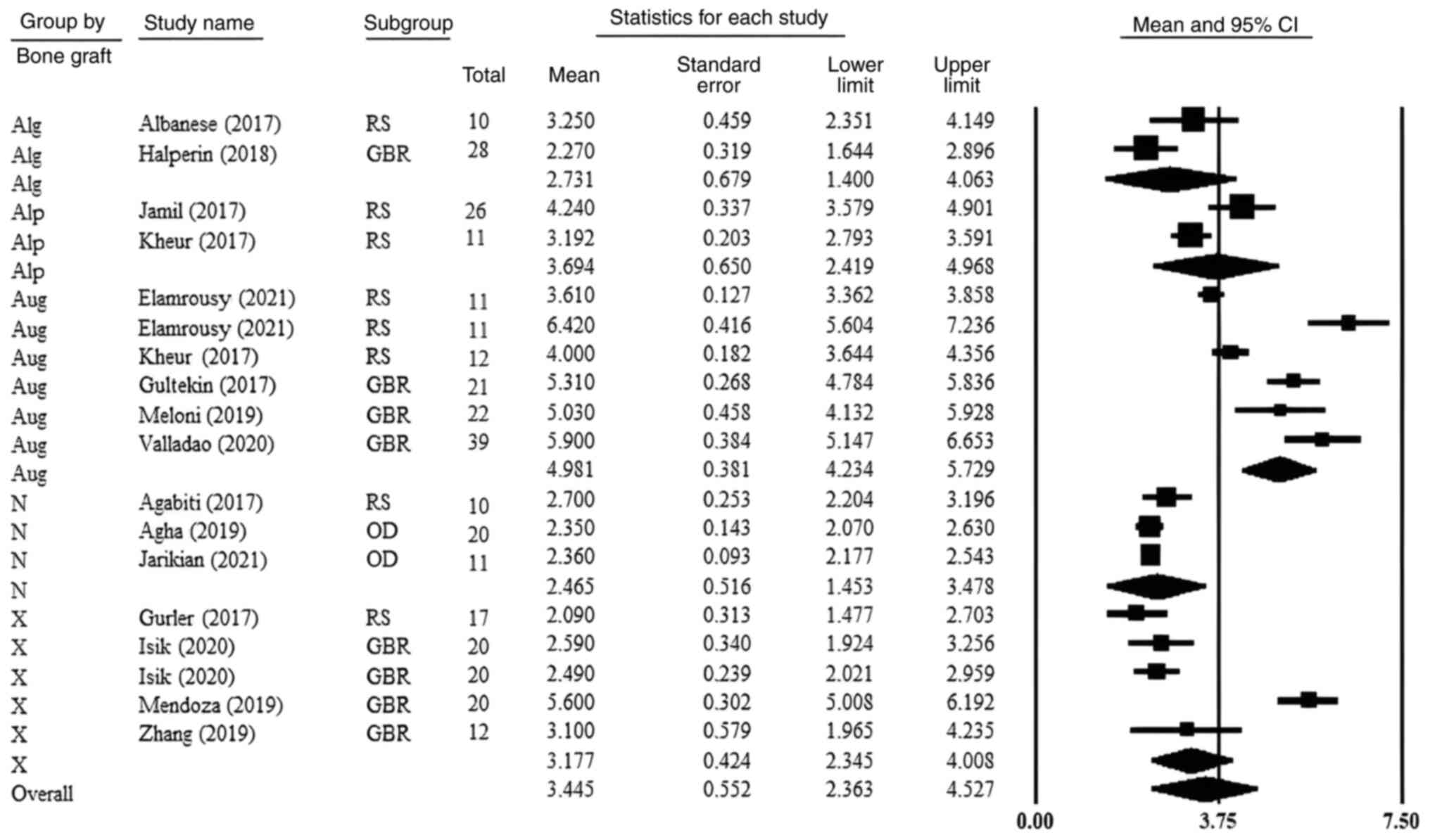 | Figure 12Forest plot of final bone gain in relation to the bone graft used. CI, confidence interval. |
Discussion
While there are a number of studies regarding the long term clinically relevant results of RS and GBR (i.e., final bone gain, resorption and recorded secondary stability), the OD technique is not as well documented in a way that can provide long term data so that a proper conclusion regarding the ideal surgical technique could be drawn. A published meta-analysis on the augmentation of horizontal ridge defects (2014) identified an increase in ridge width of 3.31 mm (38). This result is similar to the outcome of the present study, in which a bone gain of 3.3 mm (2.211-4.33 mm 95%CI) was identified. A systematic review conducted in 2018(19) reported bone gain values through bone regeneration guided by 2.27±1.68 mm. The present review included studies published from 1997 to 2014. In the present study, the mean bone gain for studies using GBR was much higher at 4.036 mm (3.351-4.772 mm 95%CI). However, the 2018 meta-analysis only considered studies using a xenogeneic bone substitute. The mean bone gain in the xenogeneic graft studies included in this meta-analysis was 3.454 mm (2.134-4.744 mm 95%CI). Another meta-analysis published in 2015(39) showed comparable results, a mean of 3.9 mm (3.52-4.28 mm 95%CI), but this includes the onlay block technique. Another systematic review published in 2018(7) showed 2.59±0.29 mm (standard error) horizontal bone gain following GBR. More recent meta-analyses have not been identified. Studies using different means of improving the efficiency of GBR (PRF, titanium membrane, autogenous bone mixture and xenogeneic bone) report means greater than 4 mm. It should be taken into account that most of the studies included in these reviews and meta-analyses use GBR as a way to restore various small or medium post-extraction defects, unlike the studies in this meta-analysis which aimed at the concrete dimensional growth of the edentulous ridge. The shortcomings of the current study (high heterogeneity, short period of time of the study), but also the lack of recent systematized data (meta-analyses) related to this technique, determine the difference between the mean of the current study and those published for the time being in the literature.
Regarding the RS technique, a meta-analysis from 2015(18) estimated a mean of the final difference at the level of the ridge of 3.19 mm (2.19-4.2 mm; 95%CI), comparable to the current study. The most recent meta-analysis in 2017(3) noted a horizontal increase of 3.61 mm, agreeing with the data from the present study.
Meta-analyses that determine a mean of horizontal bone gain through ridge expansion via OD have not been published to date. In the present analysis, however, ridge expansion via OD determined results comparable to the lower portion (in terms of increasing horizontal size) of the included studies of RS and GBR.
The current review did not consider the combination of the techniques discussed. A single included study, Jamil et al (27), performed the RS technique together with GBR in certain treated cases, but this was not included in the analysis, due to the uniqueness of the phenomenon within the set of studies, but also to facilitate the subsequent statistical assessment. Studies combining ridge expansion via OD with GBR or RS with ridge expansion via OD have not been identified as such, but the studies published by Koutouzis et al (20) and Salman et al (23) used bone substitute to augment the vestibular area of the implant insertion site under the conditions recommended by the inventors of the Versah burs and the ridge expansion via OD technique (vestibular cortical bone ≤2 mm). The combination of techniques is, according to the authors, a research direction that should be considered.
A very high degree of variability in the data from the studies on GBR was observed; also evident is the overlap of the two techniques (GBR and RS) in terms of available bone and its horizontal growth rate, the statistical analysis determining P-values higher than the statistical relevance threshold.
However, there is a clear delimitation between the dimensions of the edentulous ridges to which ridge expansion via OD can be applied, but also the bone gain that can be expected from this technique. It should be taken into account that the main indication of ridge expansion via OD is a jawbone with low density, not narrow edentulous ridges. The OD technique used in order expand the ridge horizontally is dependent on the amount of basal bone (located at 5-10 mm from the top of the edentulous ridges), an aspect that was not taken into account in the present study, being highlighted only in one of the included publications. The literature has the following minimum horizontal dimensions where the use of different procedures are indicated: 3 mm for GBR (40) and 2.5-3 mm for RS (41,42), although this seems a rather arbitrary condition, as, in clinical work, surgical options are selected by assessing a number of other variables related to the basal bone mass including density, patient anatomy and practitioner experience. While the current review does not take into account every possible factor, it however reflects the minimum horizontal dimension indications, bringing new information on the applicability of ridge expansion via OD to horizontal ridge defects.
Although not as effective in terms of the horizontal growth of the edentulous ridge, ridge expansion via OD excels in its ease of application and predictability. The application of RS and GBR is highly dependent on the skill of the practitioner and the management of complications and accidents. Dehiscence and membrane exposure or bad splitting are common incidents that jeopardize the success of lateral ridge augmentation. However, implant survival rates are comparable for all augmentation methods.
Relative to the type of bone substitute, the superiority of autologous bone is further observed in the case of the analyzed techniques (GBR and RS), the onlay block bone graft technique not being included in the present study. Statistical analysis by graft has been carried out as a guide only; the present study was not intended to identify significant results in this respect.
The present review has some limitations. First of all, the studies included in this analysis are not ideal, as they are not, entirely, randomized controlled studies. Some included studies present the results of different demonstrations of changes in the techniques of augmentation itself, making them sensitive to a risk of bias increase. Second, the number of studies related to each technique is not similar, there being a rather large discrepancy between the samples identified for each method, ridge expansion via OD being a relatively recent procedure with few published studies as of yet. Third, the authors have not identified studies that consider the initial width of the ridge as a statistical variable, so the analysis and results from this data should be interpreted with caution.
As aforementioned, there are a number of factors on which the choice of these ways of horizontal bone augmentation depends, the current meta-analysis taking into account a very limited number of them. In the future, it will be necessary to correlate these factors in a more complex statistical model by analyzing the data of more homogeneous set of studies (from a clinical and methodological point of view) in order to obtain the most accurate results and to devise protocols that eliminate as much as possible the uncertainty in the treatment of cases of horizontal atrophy of edentulous ridges.
Taking into account the shortcomings of this investigation, the final conclusions are as follows: i) Among the techniques discussed, GBR reports the most bone gain, followed closely by the RS technique and then ridge expansion via OD, ii) the RS technique is applied to ridges with the smallest initial size, GBR and ridge expansion via OD requiring a thicker alveolar ridge iii) implant survival rate is very high for all the augmentation procedures and iv) ridge expansion via OD with Versah burs is a technique that must be considered when discussing lateral ridge augmentation. The results are not as impressive as in the case of GBR or RS, but its predictability and ease of application are preferable factors for clinicians.
Acknowledgements
Not applicable.
Funding
Funding: No funding was received.
Availability of data and materials
The data generated in the present study are included in the figures and/or tables of this article.
Authors' contributions
VA, SD and AP conceived and designed the present study, which was co-ordinated by AP and SD. VA and SD were responsible for data collection and confirm the authenticity of all the raw data. VA, SD and AP were responsible for data management, analysis and interpretation. VA and SD wrote the present study. All authors read and approved the final manuscript.
Ethics approval and consent to participate
Not applicable.
Patient consent for publication
Not applicable.
Competing interests
The authors declare that they have no competing interests.
References
|
Nentwig GH: Technic of bone splitting for alveolar recession in anterior maxillary region. Quintessenz. 37:1825–1834. 1986.PubMed/NCBI(In German). | |
|
Inchingolo AD, Inchingolo AM, Bordea IR, Xhajanka E, Romeo DM, Romeo M, Zappone CMF, Malcangi G, Scarano A, Lorusso F, et al: The effectiveness of osseodensification drilling protocol for implant site osteotomy: A systematic review of the literature and meta-analysis. Materials (Basel). 14(1147)2021.PubMed/NCBI View Article : Google Scholar | |
|
Waechter J, Leite FR, Nascimento GG, Carmo Filho LC and Faot F: The split crest technique and dental implants: A systematic review and meta-analysis. Int J Oral Maxillofac Surg. 46:116–128. 2017.PubMed/NCBI View Article : Google Scholar | |
|
Starch-Jensen T and Becktor JP: Maxillary alveolar ridge expansion with split-crest technique compared with lateral ridge augmentation with autogenous bone block graft: A systematic review. J Oral Maxillofac Res. 10(e2)2019.PubMed/NCBI View Article : Google Scholar | |
|
Schopper C, Goriwoda W, Moser D, Spassova E, Watzinger F and Ewers R: Long-term results after guided bone regeneration with resorbable and microporous titanium membranes. Oral Maxillofac Surg Clin N Am. 13:449–458. 2001. | |
|
Tolstunov L: Classification of the alveolar ridge width: Implant-driven treatment considerations for the horizontally deficient alveolar ridges. J Oral Implantol. 40:365–370. 2014.PubMed/NCBI View Article : Google Scholar | |
|
Elnayef B, Porta C, Suárez-López Del Amo F, Mordini L, Gargallo-Albiol J and Hernández-Alfaro F: The fate of lateral ridge augmentation: A systematic review and meta-analysis. Int J Oral Maxillofac Implants. 33:622–635. 2018.PubMed/NCBI View Article : Google Scholar | |
|
Huwais S and Meyer EG: A novel osseous densification approach in implant osteotomy preparation to increase biomechanical primary stability, bone mineral density, and bone-to-implant contact. Int J Oral Maxillofac Implants. 32:27–36. 2017.PubMed/NCBI View Article : Google Scholar | |
|
Pai UY, Rodrigues SJ, Talreja KS and Mundathaje M: Osseodensification-a novel approach in implant dentistry. J Indian Prosthodont Soc. 18:196–200. 2018.PubMed/NCBI View Article : Google Scholar | |
|
Frizzera F, Spin-Neto R, Padilha V, Nicchio N, Ghiraldini B, Bezerra F and Marcantonio E Jr: Effect of osseodensification on the increase in ridge thickness and the prevention of buccal peri-implant defects: An in vitro randomized split mouth pilot study. BMC Oral Health. 22(233)2022.PubMed/NCBI View Article : Google Scholar | |
|
Zhou L, Su Y and Wang J, Wang X, Liu Q and Wang J: Effect of exposure rates with customized versus conventional titanium mesh on guided bone regeneration: Systematic review and meta-analysis. J Oral Implantol. 48:339–346. 2022.PubMed/NCBI View Article : Google Scholar | |
|
Carini F, Longoni S, Amosso E, Paleari J, Carini S and Porcaro G: Bone augmentation with TiMesh. autologous bone versus autologous bone and bone substitutes. A systematic review. Ann Stomatol (Roma). 5 (Suppl 2 to No 2):S27–S36. 2014.PubMed/NCBI | |
|
Tolstunov L, Hamrick JFE, Broumand V, Shilo D and Rachmiel A: Bone augmentation techniques for horizontal and vertical alveolar ridge deficiency in oral implantology. Oral Maxillofac Surg Clin North Am. 31:163–191. 2019.PubMed/NCBI View Article : Google Scholar | |
|
Arnal HM, Angioni CD, Gaultier F, Urbinelli R and Urban IA: Horizontal guided bone regeneration on knife-edge ridges: A retrospective case-control pilot study comparing two surgical techniques. Clin Implant Dent Relat Res. 24:211–221. 2022.PubMed/NCBI View Article : Google Scholar | |
|
Atef M, Tarek A, Shaheen M, Alarawi RM and Askar N: Horizontal ridge augmentation using native collagen membrane vs titanium mesh in atrophic maxillary ridges: Randomized clinical trial. Clin Implant Dent Relat Res. 22:156–166. 2020.PubMed/NCBI View Article : Google Scholar | |
|
Slim K, Nini E, Forestier D, Kwiatkowski F, Panis Y and Chipponi J: Methodological index for non-randomized studies (minors): Development and validation of a new instrument. ANZ J Surg. 73:712–716. 2003.PubMed/NCBI View Article : Google Scholar | |
|
Higgins JPT, Altman DG, Gøtzsche PC, Jüni P, Moher D, Oxman AD, Savovic J, Schulz KF, Weeks L, Sterne JA, et al: The cochrane collaboration's tool for assessing risk of bias in randomised trials. BMJ. 343(d5928)2011.PubMed/NCBI View Article : Google Scholar | |
|
Elnayef B, Monje A, Lin GH, Gargallo-Albiol J, Chan HL, Wang HL and Hernández-Alfaro F: Alveolar ridge split on horizontal bone augmentation: A systematic review. Int J Oral Maxillofac Implants. 30:596–606. 2015.PubMed/NCBI View Article : Google Scholar | |
|
Wessing B, Lettner S and Zechner W: Guided bone regeneration with collagen membranes and particulate graft materials: A systematic review and meta-analysis. Int J Oral Maxillofac Implants. 33:87–100. 2018.PubMed/NCBI View Article : Google Scholar | |
|
Koutouzis T, Huwais S, Hasan F, Trahan W, Waldrop T and Neiva R: Alveolar ridge expansion by osseodensification-mediated plastic deformation and compaction autografting: A multicenter retrospective study. Implant Dent. 28:349–355. 2019.PubMed/NCBI View Article : Google Scholar | |
|
Agha MM and El-Mohandes WA: Evolution of implant placement in narrow alveolar ridge using versah drills. Al-Azhar J Dent Sci. 22:247–251. 2019. | |
|
Jarikian S, Jaafo MH and Al-Nerabieah Z: Clinical evaluation of two techniques for narrow alveolar ridge expansion: Clinical study. Int J Dent Oral Sci. 8:1047–1052. 2021. | |
|
Salman RD and Bede SY: The use of osseodensification for ridge expansion and dental implant placement in narrow alveolar ridges: A prospective observational clinical study. J Craniofac Surg. 33:2114–2117. 2022.PubMed/NCBI View Article : Google Scholar | |
|
Agabiti I and Botticelli D: Two-stage ridge split at narrow alveolar mandibular bone ridges. J Oral Maxillofac Surg. 75:2115.e1–2115.e12. 2017.PubMed/NCBI View Article : Google Scholar | |
|
Albanese M, Ricciardi G, Luciano U, Donadello D, Lucchese A, Gelpi F, Zangani A, De Santis D, Rizzini A, Rossetto A and Bertossi D: Alveolar splitting with Piezosurgery®, bone bank grafts and NobelActive implants as an alternative to major bone grafting for maxillary reconstruction. Minerva Stomatol. 68:3–10. 2019.PubMed/NCBI View Article : Google Scholar | |
|
Gurler G, Delilbasi C, Garip H and Tufekcioglu S: Comparison of alveolar ridge splitting and autogenous onlay bone grafting to enable implant placement in patients with atrophic jaw bones. Saudi Med J. 38:1207–1212. 2017.PubMed/NCBI View Article : Google Scholar | |
|
Jamil FA and Al-Adili SS: Lateral ridge splitting (expansion) with immediate placement of endosseous dental implant using piezoelectric device: A new treatment protocol. J Craniofac Surg. 28:434–439. 2017.PubMed/NCBI View Article : Google Scholar | |
|
Kheur MG, Kheur S, Lakha T, Jambhekar S, Le B and Jain V: Does graft particle type and size affect ridge dimensional changes after alveolar ridge split procedure? J Oral Maxillofac Surg. 76:761–769. 2018.PubMed/NCBI View Article : Google Scholar | |
|
Mahmoud ZT, Wainwright M and Troedhan A: Flapless piezotome crest split achieves comparable outcomes to autologous onlay grafts with significant less patient morbidity and complications-a randomized clinical study. J Oral Maxillofac Surg. 78:1953–1964. 2020.PubMed/NCBI View Article : Google Scholar | |
|
Elamrousy W, Osama M and Issa DR: Autogenous bone and bioactive glass around implants placed simultaneously with ridge splitting for the treatment of horizontal bony defects: A randomised clinical trial. Int J Dent. 2021(2457328)2021.PubMed/NCBI View Article : Google Scholar | |
|
Gultekin BA, Cansiz E and Borahan MO: Clinical and 3-dimensional radiographic evaluation of autogenous iliac block bone grafting and guided bone regeneration in patients with atrophic maxilla. J Oral Maxillofac Surg. 75:709–722. 2017.PubMed/NCBI View Article : Google Scholar | |
|
Halperin-Sternfeld M, Zigdon-Giladi H, Shapira L and Wilensky A: Lateral guided bone regeneration using a novel synthetic bioresorbable membrane: A two center prospective randomized controlled trial running title: A novel membrane for ridge augmentation. J Mol Clin Med. 1:169–176. 2018. | |
|
Meloni SM, Jovanovic SA, Urban I, Baldoni E, Pisano M and Tallarico M: Horizontal ridge augmentation using GBR with a native collagen membrane and 1:1 ratio of particulate xenograft and autologous bone: A 3-year after final loading prospective clinical study. Clin Implant Dent Relat Res. 21:669–677. 2019.PubMed/NCBI View Article : Google Scholar | |
|
Mendoza-Azpur G, de la Fuente A, Chavez E, Valdivia E and Khouly I: Horizontal ridge augmentation with guided bone regeneration using particulate xenogenic bone substitutes with or without autogenous block grafts: A randomized controlled trial. Clin Implant Dent Relat Res. 21:521–530. 2019.PubMed/NCBI View Article : Google Scholar | |
|
Zhang T, Zhang T and Cai X: The application of a newly designed L-shaped titanium mesh for GBR with simultaneous implant placement in the esthetic zone: A retrospective case series study. Clin Implant Dent Relat Res. 21:862–872. 2019.PubMed/NCBI View Article : Google Scholar | |
|
Amaral Valladão CA Jr, Freitas Monteiro M and Joly JC: Guided bone regeneration in staged vertical and horizontal bone augmentation using platelet-rich fibrin associated with bone grafts: A retrospective clinical study. Int J Implant Dent. 6(72)2020.PubMed/NCBI View Article : Google Scholar | |
|
Işık G, Özden Yüce M, Koçak-Topbaş N and Günbay T: Guided bone regeneration simultaneous with implant placement using bovine-derived xenograft with and without liquid platelet-rich fibrin: A randomized controlled clinical trial. Clin Oral Investig. 25:5563–5575. 2021.PubMed/NCBI View Article : Google Scholar | |
|
Ortega-Oller I, Suárez F, Galindo-Moreno P, Torrecillas-Martínez L, Monje A, Catena A and Wang HL: The influence of implant diameter on its survival: A meta-analysis based on prospective clinical trials. J Periodontol. 85:569–580. 2014.PubMed/NCBI View Article : Google Scholar | |
|
Sanz-Sánchez I, Ortiz-Vigón A, Sanz-Martín I, Figuero E and Sanz M: Effectiveness of lateral bone augmentation on the alveolar crest dimension: A systematic review and meta-analysis. J Dent Res. 94 (9 Suppl):128S–142S. 2015.PubMed/NCBI View Article : Google Scholar | |
|
Stevens MR, Ghasemi S and Tabrizi R (eds): Innovative perspectives in oral and maxillofacial surgery. Springer, Cham, 2021. | |
|
Sohn DS, Lee HJ, Heo JU, Moon JW, Park IS and Romanos GE: Immediate and delayed lateral ridge expansion technique in the atrophic posterior mandibular ridge. J Oral Maxillofac Surg. 68:2283–2290. 2010.PubMed/NCBI View Article : Google Scholar | |
|
Jha N, Choi EH, Kaushik NK and Ryu JJ: Types of devices used in ridge split procedure for alveolar bone expansion: A systematic review. PLoS One. 12(e0180342)2017.PubMed/NCBI View Article : Google Scholar |



